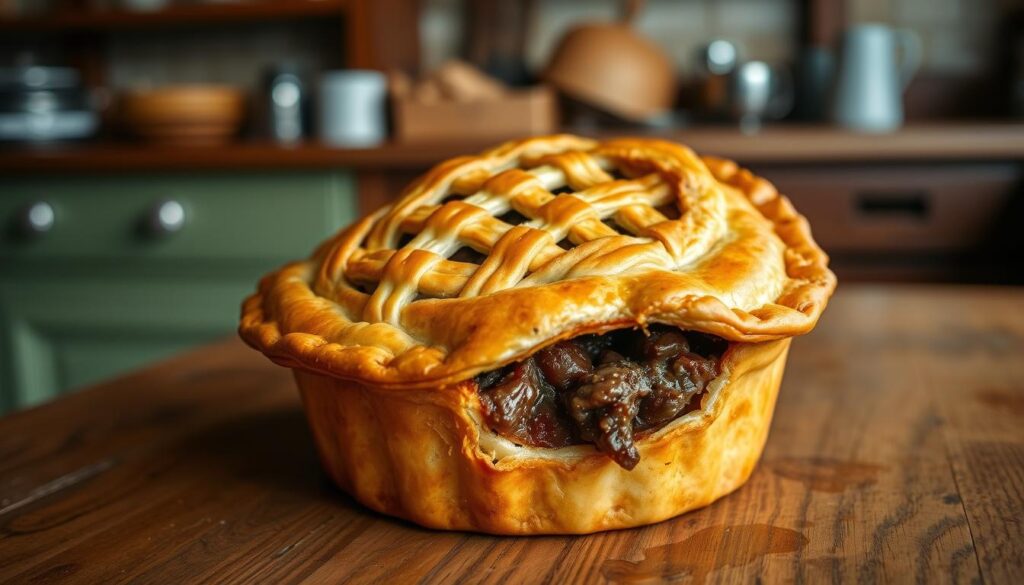At Historical Foods, we’ve always been fascinated by the traditional steak and kidney pie, a quintessential British dish that has been a comfort food staple for generations. Our team has meticulously researched and tested various recipes to bring you a scientifically-informed version that delivers exceptional results.
Understanding the culinary chemistry behind this classic dish is key to its preparation. From the behavior of proteins during slow cooking to the development of complex flavors, we’ve explored it all to help you achieve the perfect balance of tender meat, rich gravy, and flaky pastry.
By combining traditional techniques with modern food science, we’ve analyzed critical factors such as temperature control, ingredient selection, and precise timing to eliminate guesswork from your cooking process.
Key Takeaways
- Scientifically-informed recipe for traditional steak and kidney pie
- Understanding protein behavior during slow cooking
- Techniques for achieving tender meat and flaky pastry
- Critical factors for successful pie making: temperature control, ingredient selection, and timing
- Practical steps and theoretical knowledge for mastering the dish
The Rich Heritage of Steak and Kidney Pie
With its roots deeply embedded in British history, steak and kidney pie has evolved into a beloved national dish. This traditional steak and kidney pie is a quintessential example of British culinary heritage, distinct from its cousin, steak and kidney pudding.

A British Culinary Classic
Britain and Ireland are renowned for their savory and sweet pies, and steak and kidney pie stands out as a comfort food icon. We observe that this dish has been a staple through times of war and economic hardship, providing sustenance and warmth to families. Its enduring presence in British cuisine is a testament to its significance.
From Wartime Staple to Modern Comfort Food
During wartime rationing, steak and kidney pie became an economical solution to extend limited meat supplies while maintaining nutritional value. We’ve examined how home cooks’ resourcefulness during challenging periods shaped this recipe. Today, it remains a cherished comfort food, appearing on gastropub menus and in home kitchens as a connection to culinary heritage. The evolution from a necessity to a beloved classic demonstrates its deep embedding in British culinary consciousness.
The Science of Perfect Steak and Kidney Pie
The science behind a perfect Steak and Kidney Pie is multifaceted, involving the chemistry of meat, pastry, and cooking techniques. To achieve culinary excellence, we must consider several key factors.
Understanding Meat Proteins and Slow Cooking
Slow cooking is essential for tenderizing the meat in Steak and Kidney Pie. The process involves breaking down the proteins and connective tissues, making the meat tender and flavorful. We achieve this through low-temperature cooking over an extended period.
The Role of Kidneys: Flavor Development and Preparation
The kidneys add a unique flavor dimension to the pie. Proper preparation involves cleaning and dicing the kidneys, then cooking them with the beef to create a rich, savory filling. The combination of beef and kidneys enhances the overall flavor profile.
Pastry Science: Creating the Perfect Crust
Creating the perfect pastry crust involves manipulating fat distribution within flour to create distinct layers. Temperature control is crucial; keeping ingredients cold prevents premature melting of fat, maintaining the dough’s structural integrity. Using lower protein flour results in a tender crust, ideal for pie crusts. Minimal handling prevents overdevelopment of gluten, ensuring a flaky rather than tough crust.
- The interaction between the hot filling and pastry bottom requires careful management through proper cooling and baking techniques.
- Our testing has shown that the science of pastry creation is crucial for achieving the desired texture and flavor.

Essential Ingredients and Their Purpose
The magic of Steak and Kidney Pie lies in its ingredients and their roles. To create an authentic dish, it’s crucial to understand the purpose of each component and how they work together to produce a harmonious flavor profile.
Selecting the Right Cuts of Beef and Kidney
We emphasize the importance of choosing the right cuts of beef and kidney for an authentic Steak and Kidney Pie. Chuck or round beef works well due to their balance of flavor and texture. For kidneys, we recommend using beef or lamb kidneys, which provide a rich, meaty flavor.
The Supporting Cast: Vegetables and Seasonings
Vegetables and seasonings play a vital role in enhancing the flavor of Steak and Kidney Pie. Onions, carrots, and celery form the aromatic base, while thyme and bay leaves add depth. We also recommend adding a dash of Dijon mustard to brighten the flavors.
Building Flavor with Stock and Worcestershire Sauce
A high-quality beef stock is essential for creating a rich, savory sauce. We’ve found that homemade stock produces superior results, but store-bought alternatives can be used with modifications. Adding Worcestershire sauce enhances the umami flavor, with its fermented nature adding a subtle acidic note that brightens the filling.
| Ingredient | Purpose | Recommended Type |
|---|---|---|
| Beef | Main protein source | Chuck or round |
| Kidney | Flavor and texture | Beef or lamb |
| Stock | Sauce foundation | Homemade beef stock |
| Worcestershire sauce | Umami flavor enhancer | Traditional recipe |
Our Tested Steak and Kidney Pie Recipe
Now that we’ve explored the rich heritage and science behind Steak and Kidney Pie, it’s time to dive into our tested recipe. This classic dish, perfected through rigorous testing, combines tender beef, flavorful kidneys, and a flaky pastry crust.
Preparing the Filling
The filling is the heart of any Steak and Kidney Pie. It requires careful preparation to achieve the perfect balance of flavors and textures.
Cleaning and Preparing Kidneys
When using kidneys, it’s crucial to clean and prepare them properly. Remove any membranes and cut them into suitable sizes for even cooking. This step ensures they blend well with the beef and gravy.
Browning Meat for Maximum Flavor
Browning the meat is a critical step that enhances the overall flavor. By searing the beef in hot oil, we create a rich, caramelized crust that adds depth to the filling.
Creating the Rich Gravy Base
The gravy base is developed by deglazing the pan with a mixture of stock and Worcestershire Sauce, capturing all the browned bits. This process enriches the gravy, giving it a complex, savory flavor.
Making the Perfect Pastry
A good Steak and Kidney Pie relies on a flaky, golden-brown pastry crust. Achieving this requires attention to detail and the right techniques.
Cold Ingredients: The Secret to Flaky Crust
Using cold ingredients is essential for creating a flaky crust. Cold butter and ice-cold water help to maintain the butter’s integrity, leading to a layered, tender pastry.
Rolling and Shaping Techniques
When rolling out the pastry, it’s important to maintain even thickness and handle the dough gently to prevent it from becoming tough.
Egg Wash Application for Golden Results
Brushing the pastry with an egg wash before baking gives it a rich, golden brown color. This not only enhances the appearance but also adds a subtle sheen.
Assembly and Baking
The final steps involve assembling the pie and baking it to perfection in the oven.
Proper Filling Temperature
Ensure the filling is hot before covering it with pastry. This helps the pastry cook evenly and prevents it from becoming soggy.
Steam Vents and Their Importance
Creating steam vents in the pastry lid allows steam to escape during baking, preventing the pie from bursting open and ensuring the crust remains crisp.
Baking Times and Temperature Control
Preheat the oven to 200°C/gas 6/fan 180°C. Make four slashes in the lid of the pie, then brush with the egg wash. Bake for 35-45 minutes until the pastry is golden brown, turning the heat down 10-20° after about 20 minutes. This method ensures a perfectly cooked crust and filling.
Serving Suggestions and Flavor Variations
As we conclude our exploration of Steak and Kidney Pie, it’s clear that this classic dish offers both rich history and culinary versatility. Our tested recipe provides a foundation for traditional preparation, while our serving suggestions and flavor variations offer ample opportunity for creativity. Traditional accompaniments like mushy peas or a simple green salad complement the pie’s rich flavors, while additions such as mushrooms or oysters can introduce new dimensions. For special occasions, consider serving with a rich red wine reduction sauce to add elegant complexity. We’ve found that the pie benefits from a brief resting period after baking, allowing the filling to set for cleaner slicing. When reheating leftovers, place the pie in a preheated 350°F oven for 15-25 minutes, or until it reaches 165°F. Explore more recipes and culinary insights on Historical Foods.


